国际市场营销学 第12章 Marketing Communications-PPT精品文档
- 格式:ppt
- 大小:210.00 KB
- 文档页数:17
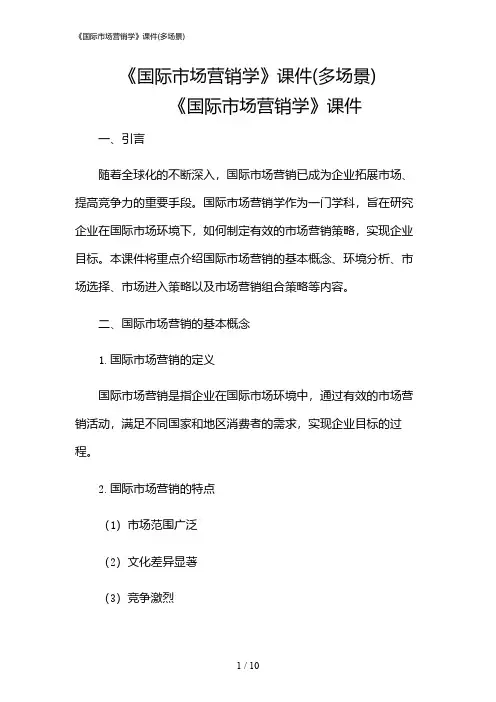
《国际市场营销学》课件(多场景)《国际市场营销学》课件一、引言随着全球化的不断深入,国际市场营销已成为企业拓展市场、提高竞争力的重要手段。
国际市场营销学作为一门学科,旨在研究企业在国际市场环境下,如何制定有效的市场营销策略,实现企业目标。
本课件将重点介绍国际市场营销的基本概念、环境分析、市场选择、市场进入策略以及市场营销组合策略等内容。
二、国际市场营销的基本概念1.国际市场营销的定义国际市场营销是指企业在国际市场环境中,通过有效的市场营销活动,满足不同国家和地区消费者的需求,实现企业目标的过程。
2.国际市场营销的特点(1)市场范围广泛(2)文化差异显著(3)竞争激烈(4)政治、经济、法律环境复杂三、国际市场营销环境分析1.宏观环境分析(1)政治环境(2)经济环境(3)法律环境(4)文化环境2.微观环境分析(1)企业内部资源(2)竞争对手分析(3)供应商和分销商分析(4)顾客需求分析四、国际市场选择1.市场细分市场细分是指将国际市场划分为若干具有相似需求特征的消费者群体,以便企业能够更好地满足这些群体的需求。
2.目标市场选择(1)市场潜力(2)市场吸引力(3)企业资源和能力(4)竞争状况3.市场定位市场定位是指企业根据目标市场的需求和竞争状况,确定产品或服务的市场地位,塑造企业独特的市场形象。
五、国际市场进入策略1.出口策略出口策略是指企业在国内生产产品,然后通过外贸渠道销售到国外市场。
2.许可策略许可策略是指企业将专利、技术、品牌等授权给国外企业使用,以获取收益。
3.合资策略合资策略是指企业与国外企业共同投资、共同经营,分享利润和风险。
4.直接投资策略直接投资策略是指企业在国外市场设立生产基地,进行生产、销售和服务。
六、国际市场营销组合策略1.产品策略(1)产品标准化与差异化(2)品牌策略(3)包装策略2.价格策略(1)定价方法(2)价格调整策略3.渠道策略(1)直销渠道(2)分销渠道4.促销策略(1)广告策略(2)人员推销策略(3)营业推广策略(4)公关策略七、结论国际市场营销学为企业提供了在国际市场环境中制定有效市场营销策略的理论和方法。
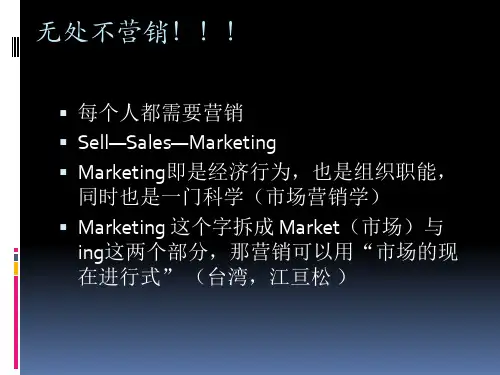
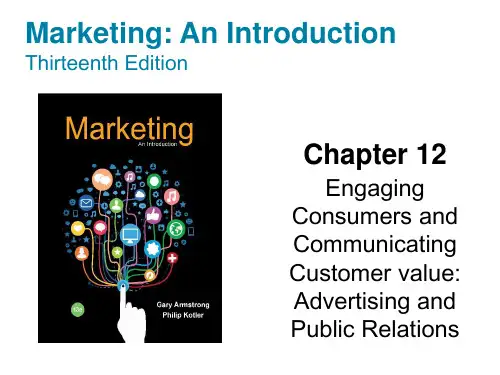

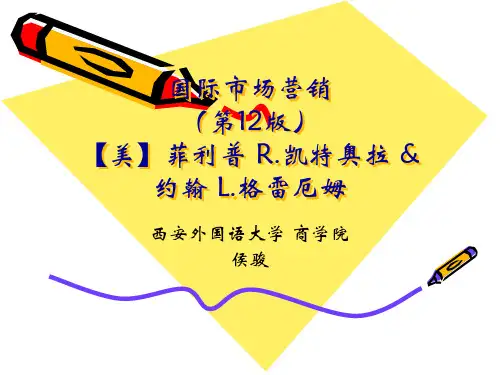
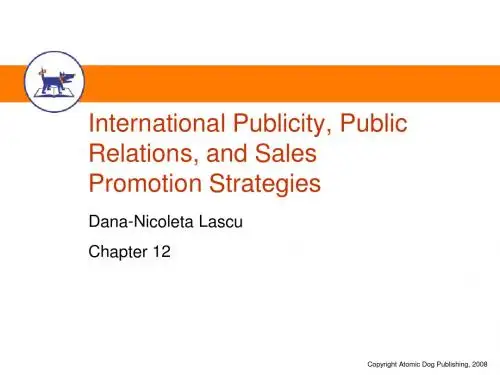
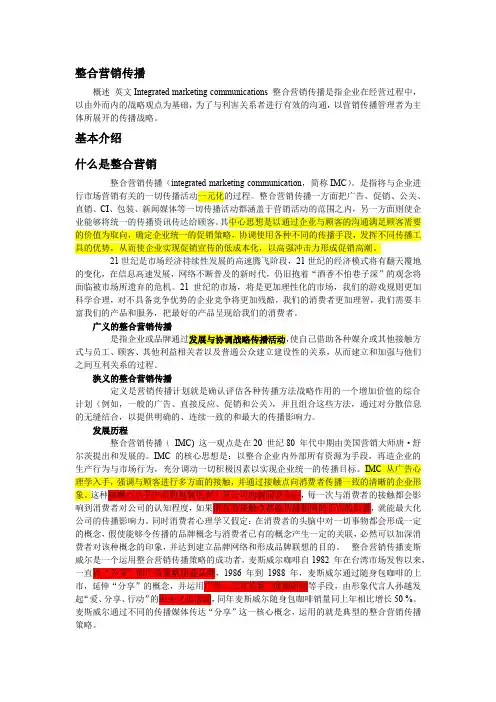
整合营销传播概述英文Integrated marketing communications 整合营销传播是指企业在经营过程中,以由外而内的战略观点为基础,为了与利害关系者进行有效的沟通,以营销传播管理者为主体所展开的传播战略。
基本介绍什么是整合营销整合营销传播(integrated marketing communication,简称IMC)。
是指将与企业进行市场营销有关的一切传播活动一元化的过程。
整合营销传播一方面把广告、促销、公关、直销、CI、包装、新闻媒体等一切传播活动都涵盖于营销活动的范围之内,另一方面则使企业能够将统一的传播资讯传达给顾客。
其中心思想是以通过企业与顾客的沟通满足顾客需要的价值为取向,确定企业统一的促销策略,协调使用各种不同的传播手段,发挥不同传播工具的优势,从而使企业实现促销宣传的低成本化,以高强冲击力形成促销高潮。
21世纪是市场经济持续性发展的高速腾飞阶段,21世纪的经济模式将有翻天覆地的变化,在信息高速发展,网络不断普及的新时代,仍旧抱着“酒香不怕巷子深”的观念将面临被市场所遗弃的危机。
21世纪的市场,将是更加理性化的市场,我们的游戏规则更加科学合理,对不具备竞争优势的企业竞争将更加残酷,我们的消费者更加理智,我们需要丰富我们的产品和服务,把最好的产品呈现给我们的消费者。
广义的整合营销传播是指企业或品牌通过发展与协调战略传播活动,使自己借助各种媒介或其他接触方式与员工、顾客、其他利益相关者以及普通公众建立建设性的关系,从而建立和加强与他们之间互利关系的过程。
狭义的整合营销传播定义是营销传播计划就是确认评估各种传播方法战略作用的一个增加价值的综合计划(例如,一般的广告、直接反应、促销和公关),并且组合这些方法,通过对分散信息的无缝结合,以提供明确的、连续一致的和最大的传播影响力。
发展历程整合营销传播(IMC) 这一观点是在20 世纪80 年代中期由美国营销大师唐·舒尔茨提出和发展的。
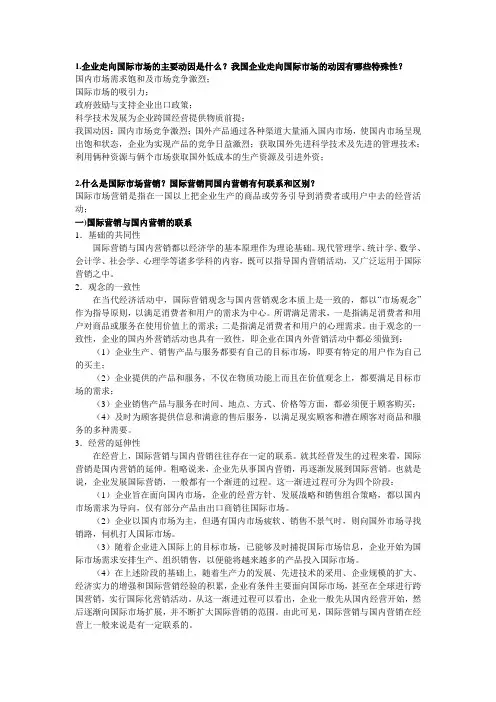
1.企业走向国际市场的主要动因是什么?我国企业走向国际市场的动因有哪些特殊性?国内市场需求饱和及市场竞争激烈;国际市场的吸引力;政府鼓励与支持企业出口政策;科学技术发展为企业跨国经营提供物质前提;我国动因:国内市场竞争激烈;国外产品通过各种渠道大量涌入国内市场,使国内市场呈现出饱和状态,企业为实现产品的竞争日益激烈;获取国外先进科学技术及先进的管理技术;利用俩种资源与俩个市场获取国外低成本的生产资源及引进外资;2.什么是国际市场营销?国际营销同国内营销有何联系和区别?国际市场营销是指在一国以上把企业生产的商品或劳务引导到消费者或用户中去的经营活动;一)国际营销与国内营销的联系1.基础的共同性国际营销与国内营销都以经济学的基本原理作为理论基础。
现代管理学、统计学、数学、会计学、社会学、心理学等诸多学科的内容,既可以指导国内营销活动,又广泛运用于国际营销之中。
2.观念的一致性在当代经济活动中,国际营销观念与国内营销观念本质上是一致的,都以“市场观念”作为指导原则,以满足消费者和用户的需求为中心。
所谓满足需求,一是指满足消费者和用户对商品或服务在使用价值上的需求;二是指满足消费者和用户的心理需求。
由于观念的一致性,企业的国内外营销活动也具有一致性,即企业在国内外营销活动中都必须做到:(1)企业生产、销售产品与服务都要有自己的目标市场,即要有特定的用户作为自己的买主;(2)企业提供的产品和服务,不仅在物质功能上而且在价值观念上,都要满足目标市场的需求;(3)企业销售产品与服务在时间、地点、方式、价格等方面,都必须便于顾客购买;(4)及时为顾客提供信息和满意的售后服务,以满足现实顾客和潜在顾客对商品和服务的多种需要。
3.经营的延伸性在经营上,国际营销与国内营销往往存在一定的联系。
就其经营发生的过程来看,国际营销是国内营销的延伸。
粗略说来,企业先从事国内营销,再逐渐发展到国际营销。
也就是说,企业发展国际营销,一般都有一个渐进的过程。

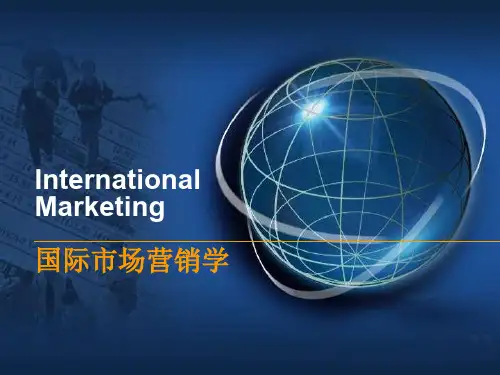

SY第十二章临时抵押Value delivery network价值传递网络A network composed of the company. suppliers, distributors, and, ultimately,customers who partner with each other to improve the performance of the entire system in delivering customer value.由公司组成的网络。
供应商、分销商,以及最终相互合作的客户,以提高整个系统在交付客户价值方面的性能。
Marketing channel (or distribution channel)营销渠道(或分销渠道)A set of interdependent organizations that help make a product or service available for use or consumption by the consumer or business user.一组相互依赖的组织,帮助使产品或服务可供消费者或业务用户使用或消费。
Channel level信道级A layer of intermediaries that performs some work in bringing the product and its ownership closer to the final buyer.使产品及其所有权更接近最终购买者的中介层。
Direct marketing channel直销渠道A marketing channel that has no intermediary levels.没有中间层的营销渠道。
Indirect marketing channel间接营销渠道A marketing channel containing one or more intermediary levels.包含一个或多个中间层的营销渠道。
国际市场营销学培训讲义(英文版) International Marketing Training HandbookSession 1: Introduction to International Marketing1.1 Definition of International Marketing- Explanation of international marketing and its importance in today's globalized world.- Overview of key concepts, such as globalization, market segmentation, and cultural diversity.1.2 Benefits and Challenges of International Marketing- Discussion on the advantages of expanding into international markets, such as increased sales and new business opportunities. - Identification of common challenges, such as cultural differences, legal and regulatory complexities, and competitive pressures.1.3 International Marketing Strategies- Introduction to different strategies for entering international markets, including exporting, licensing, joint ventures, and direct investment.- Examination of factors influencing strategy selection, such as market potential, risk assessment, and resource allocation. Session 2: Market Research and Analysis2.1 Understanding Global Consumers- Analysis of cultural differences and their impact on consumer behavior.- Identification of global consumer segments and trends to targeteffectively.2.2 Market Research Methods- Overview of primary and secondary research methods for gathering market intelligence.- Explanation of techniques for analyzing market data, such as surveys, focus groups, and data mining.2.3 Assessing Market Potential- Examination of key factors to consider when evaluating market potential, including market size, growth rate, and competition.- Introduction to tools and frameworks for assessing market attractiveness and competitiveness.Session 3: Market Entry Strategies3.1 Exporting and Importing- Discussion on the advantages and disadvantages of exporting and importing.- Explanation of export and import processes, including logistics, documentation, and international trade regulations.3.2 Licensing and Franchising- Overview of licensing and franchising as market entry strategies. - Examination of the benefits, risks, and considerations involved in entering into licensing and franchising agreements.3.3 Joint Ventures and Strategic Alliances- Introduction to joint ventures and strategic alliances as collaborative market entry strategies.- Analysis of the advantages, challenges, and factors for successful partnerships.Session 4: Product and Brand Management4.1 Adaptation vs. Standardization- Examination of product and brand adaptation strategies to suit local market preferences.- Discussion on the benefits and risks of standardizing products and brands across international markets.4.2 Product Development and Innovation- Overview of product development processes for international markets.- Introduction to strategies for fostering innovation and staying competitive in global markets.4.3 Branding and Positioning- Explanation of brand building and positioning strategies for global brands.- Examination of the role of culture, communication, and customer perception in successful international branding.Session 5: Communication and Promotion5.1 Integrated Marketing Communications- Introduction to integrated marketing communications (IMC) and its role in international marketing.- Explanation of different promotional tools and channels, such as advertising, public relations, and digital marketing.5.2 Cultural Sensitivity in Communication- Discussion on the importance of cultural sensitivity and adaptation in international communication.- Analysis of successful cross-cultural marketing campaigns and the lessons learned.5.3 Digital Marketing in International Markets- Overview of digital marketing strategies and tactics for reaching global audiences.- Examination of the challenges and opportunities in leveraging digital platforms for international marketing.Note: This training handbook provides an overview of key topicsin international marketing and can be customized to suit specific training objectives and participant needs.Session 6: Pricing and Distribution6.1 Pricing Strategies in International Markets- Explanation of factors affecting pricing decisions in international markets, such as currency fluctuations, local market conditions, and competition.- Introduction to pricing strategies, such as cost-based pricing, market-based pricing, and value-based pricing.6.2 Distribution Channels and Logistics- Overview of distribution channel options in international markets, including direct sales, distributors, agents, and e-commerce.- Examination of logistics considerations, such as transportation, warehousing, and customs regulations.6.3 Channel Management and Relationship Building- Discussion on the importance of effective channel management and relationship building with international partners.- Introduction to strategies for selecting, managing, and incentivizing channel partners.Session 7: Legal and Ethical Considerations7.1 International Legal Framework- Overview of international trade laws and regulations, such as tariff and non-tariff barriers, intellectual property protection, and contract laws.- Explanation of the role of international organizations, such as the World Trade Organization (WTO), in promoting fair trade practices.7.2 Ethical Issues in International Marketing- Analysis of ethical dilemmas and challenges in international marketing, such as cultural sensitivity, advertising standards, and environmental sustainability.- Discussion on the importance of corporate social responsibility (CSR) in international business practices.7.3 Risk Management and Compliance- Introduction to risk management strategies for mitigating legal and ethical risks in international marketing.- Explanation of compliance standards, such as anti-corruption laws and data privacy regulations, that businesses need to adhere to in global markets.Session 8: Market Expansion and Growth8.1 Emerging Markets and Opportunities- Analysis of emerging markets and their potential for business expansion and growth.- Discussion on strategies for entering and succeeding in emerging markets, such as adaptation to local conditions and collaboration with local partners.8.2 International Business Development- Overview of strategies and considerations for expanding and growing international business operations.- Discussion on factors such as market diversification, innovation, and strategic partnerships.8.3 Sustainable International Marketing- Examination of sustainability and responsible business practices in international marketing.- Introduction to concepts such as green marketing, social entrepreneurship, and inclusive business models.Session 9: Cross-Cultural Communication and Negotiation9.1 The Importance of Cross-Cultural Communication- Explanation of the challenges and opportunities presented by cross-cultural communication in international business.- Analysis of cultural dimensions and their impact on communication styles and business practices.9.2 Cross-Cultural Negotiation- Overview of negotiation strategies and techniques in cross-cultural settings.- Examination of cultural norms and practices that influence negotiation processes and outcomes.9.3 Managing Cultural Differences- Discussion on strategies for managing and leveraging cultural differences in international business.- Introduction to intercultural competence skills, such as empathy, adaptability, and cultural intelligence.Session 10: International Marketing Plan10.1 Developing an International Marketing Plan- Step-by-step guide to developing an international marketing plan. - Explanation of key components, such as market analysis, target market selection, marketing objectives, and implementation strategies.10.2 Evaluating and Monitoring International Marketing Performance- Introduction to metrics and tools for evaluating the performance of international marketing activities.- Discussion on the importance of monitoring and adjusting strategies based on market feedback and changing conditions. 10.3 Case Studies and Best Practices in International Marketing- Analysis of real-world case studies and best practices in international marketing.- Examination of successful international marketing campaigns and their underlying strategies and tactics.Note: This training handbook provides an overview of key topics in international marketing and can be customized to suit specific training objectives and participant needs. The content can be expanded upon by incorporating additional case studies, interactive exercises, and group discussions to enhance participant engagement and learning.。